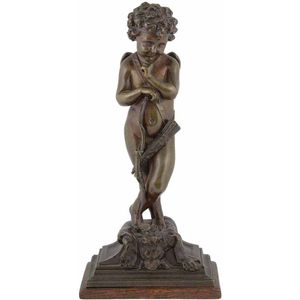Meiji Period Bronze Father and Son Sculpture
You must be a subscriber, and be logged in to view price and dealer details.
Subscribe Now to view actual auction price for this item
When you subscribe, you have the option of setting the currency in which to display prices to $Au, $US, $NZ or Stg.
- Incised - A record of a name, date or inscription, or a decoration scratched into a surface, usually of a glass or ceramic item with a blunt instrument to make a coarse indentation. Compare with engraving where the surface is cut with a sharp instrument such as a metal needle or rotating tool to achieve a fine indentation.
- Patination / Patina - In broad terms, patination refers to the exterior surface appearance of the timber, the effect of fading caused by exposure to sunlight and air over the course of a century or more, changing the piece to a soft, mellow colour.
As patina is very difficult to replicate, it is one of the most important guides to determining the age of furniture.
Patina is also the term applied to the bloom or film found on old bronzes due to oxidisation. - Bronze - An alloy of copper and tin, traditionally in the proportions of about 9 parts of copper to 1 part of tin.
The discovery of bronze in Western Asia in the 4th century enabled people to create metal objects which were superior to those previoulsy possible because of its strength and hardness, and it has been used throughout the world for weapons, coins, tools, statuary and other decorative items.
It is very fluid in a molten state, and its hardness, strength when set, and non-corrosive properties makes it most suitable for casting sculpture.
This item has been included into following indexes:
Visually similar items

A large and impressive Japanese Meiji period bronze sculpture of a young mother and child, she stands in traditional robe, her child seated to her back upon a bag, their attention drawn to her shoulder, raised on textured base, various impressed character

Affortunato Gory, Italian 1895-1925, rare gilt bronze and ivory figure holding a cat, number 829 cast after a model in a tunic holding a cat, set upon a stepped marble plinth, signed to the plinth and with cast number 829, 24.5 cm in high

Bronze figure of Cupid, after Alfred Louis Habert set upon a lion skin draped pedestal, on a velvet lined loose fitted timber stand. Height 27.5 cm

A gilt bronze Buddha seated in meditative pose, with hands in teaching mudra, raised on double lotus plinth base. Height 15.5 cm
